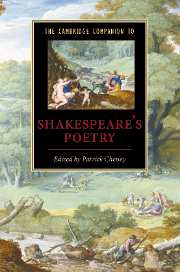Book contents
- Frontmatter
- Introduction: Shakespeare’s poetry in the twenty-first century
- 1 Shakespeare and the development of English poetry
- 2 Rhetoric, style, and poetic form
- 3 Print and manuscript
- 4 Venus and Adonis
- 5 The Rape of Lucrece
- 6 The Passionate Pilgrim and ‘The Phoenix and Turtle’
- 7 The Sonnets
- 8 A Lover’s Complaint
- 9 Poetry, politics, and religion
- 10 Love, beauty, and sexuality
- 11 Shakespeare and classicism
- 12 Poetry in Shakespeare’s plays
- 13 Poetry and performance
- 14 Reception and influence
- Reference works on Shakespeare’s poetry
- Index
14 - Reception and influence
Published online by Cambridge University Press: 28 May 2007
- Frontmatter
- Introduction: Shakespeare’s poetry in the twenty-first century
- 1 Shakespeare and the development of English poetry
- 2 Rhetoric, style, and poetic form
- 3 Print and manuscript
- 4 Venus and Adonis
- 5 The Rape of Lucrece
- 6 The Passionate Pilgrim and ‘The Phoenix and Turtle’
- 7 The Sonnets
- 8 A Lover’s Complaint
- 9 Poetry, politics, and religion
- 10 Love, beauty, and sexuality
- 11 Shakespeare and classicism
- 12 Poetry in Shakespeare’s plays
- 13 Poetry and performance
- 14 Reception and influence
- Reference works on Shakespeare’s poetry
- Index
Summary
The reception history of Shakespeare's poems is important not only for charting changing attitudes towards literary expression that, in turn, have shaped the discipline of literary studies; or, indeed, for reaching a better understanding of how Shakespeare's poetry works. It matters because it prompts us to take a step back: to think again about what it is we (and others) value most about poetry; why we are drawn to poetry in the first place, and why we continue to read, sometimes to labour over it. Reception history, in other words, is not just about history. It is about what makes literature special.
Because Shakespeare's canonical status has long been assured, his poetry is now assumed to be especially rewarding, beautiful, skilful, profound. But it was not always so. In Shakespeare's lifetime the Sonnets slipped into obscurity while the narrative poems brought him an ambivalent reputation as both a marvellously skilled poet and a purveyor of popular, wanton literature. The popularity of Venus and Adonis in the period is undisputed: it was not only Shakespeare's most frequently reprinted work before the Restoration but one of his most frequently transcribed works in manuscript in the seventeenth century - outstripping the plays from Hamlet to Lear, 1 Henry IV to Richard II, Love's Labour's Lost to Twelfth Night, and exceeded only by the songs from The Tempest and Sonnet 2. But by the eighteenth century much had changed. Not only had the narrative poems fallen to the periphery of the Shakespearean canon, but the Sonnets had become something of an aesthetic and sexual embarrassment. How could the nation's Bard write such passionate love poems to another man? What went wrong?
- Type
- Chapter
- Information
- The Cambridge Companion to Shakespeare's Poetry , pp. 260 - 280Publisher: Cambridge University PressPrint publication year: 2007
- 1
- Cited by

